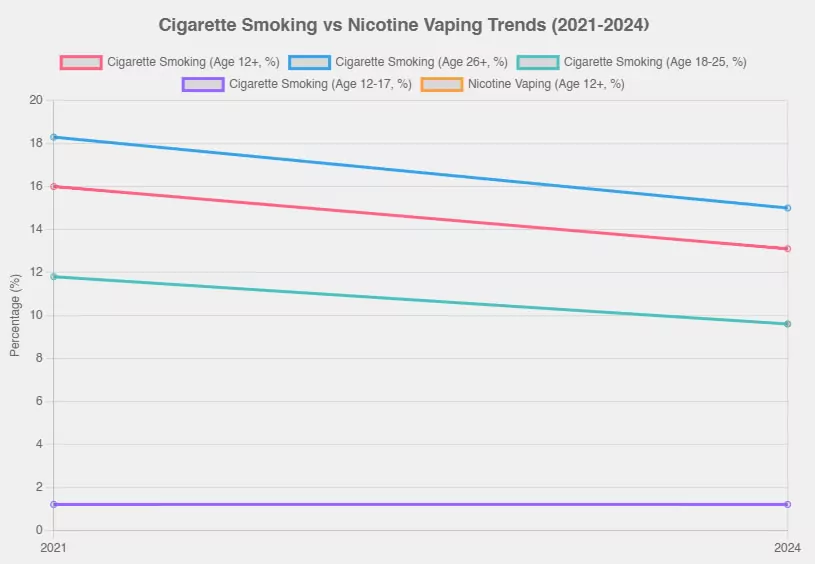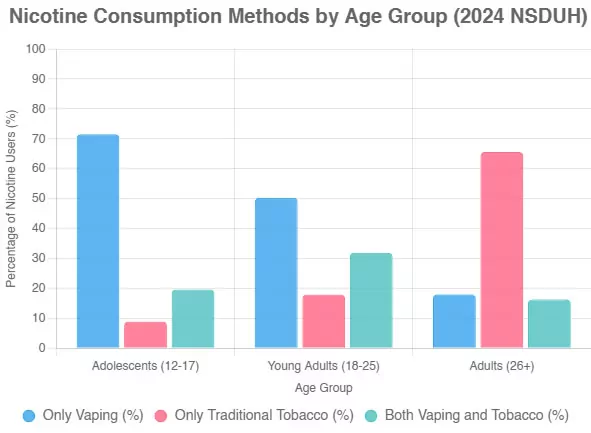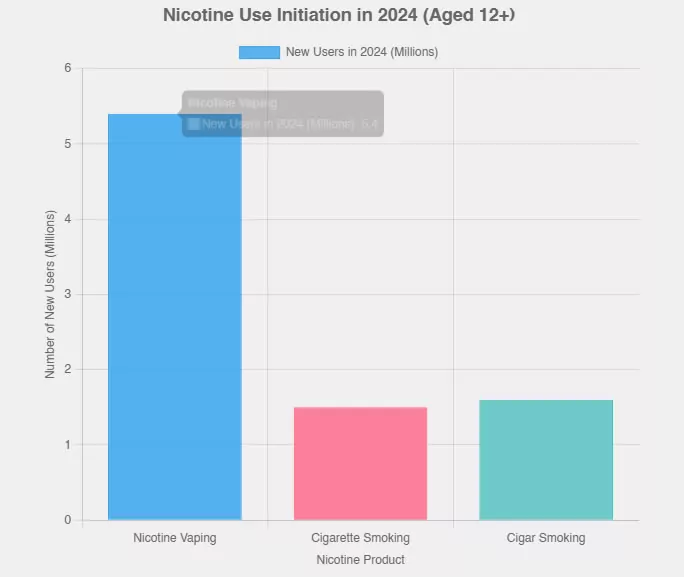US Smoking Rates Fall as Vaping Rises: 2024 NSDUH Report
The landscape of nicotine consumption in the United States is undergoing a significant transformation, with fewer Americans smoking traditional cigarettes while the use of electronic cigarettes (vaping) continues to grow. This pivotal shift is detailed in the latest 2024 National Survey on Drug Use and Health (NSDUH), a comprehensive annual report released by the Substance Abuse and Mental Health Services Administration (SAMHSA). The survey, which provides a critical snapshot of substance use and mental health across the nation, reveals a clear and sustained decline in cigarette smoking between 2021 and 2024, alongside a notable rise in nicotine vaping, particularly among young adults. This guide delves into the key findings of the 2024 NSDUH report, exploring the trends, demographic shifts, and public health implications of this evolving relationship with nicotine.
The Big Picture: A Decline in Smoking, A Rise in Vaping
The most prominent trend highlighted in the 2024 NSDUH report is the inverse relationship between cigarette smoking and nicotine vaping. The number of people aged 12 and older who reported smoking cigarettes in the past month has seen a significant decrease.
According to the survey data, the number of current cigarette smokers (those who smoked in the past 30 days) declined from 44.8 million people in 2021 to 37.8 million in 2024. This represents a drop of 7 million smokers over a three-year period. In percentage terms, the prevalence of past-month cigarette smoking among people aged 12 or older fell from 16.0% in 2021 to 13.1% in 2024.
This decline was most pronounced among adults. For those aged 26 or older, the rate of current smoking decreased from 18.3% in 2021 to 15.0% in 2024. Among young adults aged 18 to 25, the rate fell from 11.8% to 9.6% over the same period. Interestingly, the rate of cigarette smoking among adolescents aged 12 to 17 showed no statistically significant change, remaining low at 1.2% in 2024.
In contrast, nicotine vaping has solidified its place as a popular form of nicotine consumption. In 2024, 27.7 million people aged 12 or older (or 9.6% of the population) reported vaping nicotine in the past month. This trend is particularly strong among young adults.

A Generational Divide: Who is Vaping vs. Who is Smoking?
The 2024 NSDUH data reveals a stark generational divide in the preferred methods of nicotine consumption. While older adults are more likely to use traditional tobacco products, younger generations are overwhelmingly choosing vaping.
Among all individuals aged 12 or older who used any nicotine product (tobacco or vape) in the past month, the survey found:
- Adolescents (12-17): A staggering 71.5% of nicotine-using adolescents only vaped nicotine products. Only 8.9% used only traditional tobacco products, while 19.6% used both.
- Young Adults (18-25): A similar pattern emerged, with 50.3% of nicotine-using young adults only vaping. Just 17.9% used only traditional tobacco, and 31.9% used both.
- Adults (26 or Older): The trend reverses sharply in this age group. 65.6% of nicotine-using adults aged 26 or older used only traditional tobacco products. Only 18.0% exclusively vaped, while 16.3% used both.
These statistics clearly illustrate that vaping has become the dominant form of nicotine initiation and use among younger people, while traditional cigarettes remain more entrenched among the older population. In 2024, 23.7% of all young adults aged 18 to 25 (or 8.3 million people) vaped nicotine in the past month, the highest prevalence of any age group. This is compared to 6.0% of adolescents (1.6 million people) and 7.8% of adults aged 26 or older (17.8 million people).

Daily Cigarette Use and Heavy Smoking Also on the Decline
The survey not only shows fewer people are smoking cigarettes, but also that those who do smoke are smoking less heavily. Among the 37.8 million current cigarette smokers in 2024, 22.3 million (59.0%) were daily smokers. The report highlights a significant trend: the percentage of daily smokers who consumed one or more packs of cigarettes per day has declined.
In 2021, 42.4% of daily smokers (11.6 million people) smoked a pack or more per day. By 2024, this figure had dropped to 37.7% (8.4 million people). This decline was primarily driven by adults aged 26 or older, whose rate of heavy daily smoking fell from 43.3% to 38.4% over the three-year period. This suggests that not only are people quitting smoking, but those who continue are, on average, reducing their daily consumption.
Initiation of Nicotine Use: Vaping is the New Starting Point
The NSDUH report also provides critical data on the initiation of substance use, meaning the first time a person uses a particular substance. The findings confirm that vaping is now the most common entry point for nicotine use among new users.
In the 12 months prior to the 2024 survey, an estimated 5.4 million people aged 12 or older initiated nicotine vaping. This number far surpasses the initiation of traditional cigarettes. In the same period:
- 1.5 million people tried a cigarette for the first time.
- 1.6 million people tried cigars for the first time.
This means that in 2024, there were more than three times as many new vapers as there were new cigarette smokers. This data powerfully illustrates the shift in how individuals, particularly young people, are first being introduced to nicotine. Interestingly, while alcohol and marijuana initiation were predominantly among those under 21, more than half of all new nicotine vapers in 2024 were aged 26 or older, suggesting that adults are also initiating vaping at significant rates, possibly as a perceived alternative to smoking.

Interpreting the Trends: Harm Reduction vs. Public Health Concerns
The data from the 2024 NSDUH presents a complex public health picture. On one hand, the significant and sustained decline in cigarette smoking is a major public health victory. Smoking combustible tobacco is unequivocally the most harmful way to consume nicotine, responsible for millions of preventable deaths worldwide. The shift away from cigarettes, if it represents smokers moving to a less harmful alternative like vaping, could be viewed through a harm reduction lens.
On the other hand, the soaring popularity of vaping, especially among young adults and as the primary initiation product for nicotine, raises serious concerns. Public health officials worry about:
- Creating a New Generation of Nicotine Addicts: The high prevalence of vaping among young people who have never smoked suggests that e-cigarettes are creating new nicotine dependencies rather than solely serving as an off-ramp for existing smokers.
- Unknown Long-Term Health Effects: While vaping is widely considered less harmful than smoking, the long-term health effects of inhaling e-liquid constituents are still not fully understood.
- The Role of Flavors: The appeal of flavored vaping products is often cited as a key driver of youth uptake, a concern that has led to significant regulatory debate and action at both the federal and state levels.
The Broader Substance Use Context
The NSDUH report covers a wide range of substances beyond nicotine. In 2024, among people aged 12 or older:
- 168.0 million (58.3%) used tobacco, vaped nicotine, used alcohol, or used an illicit drug in the past month.
- 134.3 million (46.6%) drank alcohol in the past month.
- 48.2 million (16.7%) used an illicit drug in the past month, with marijuana being the most common (44.3 million users).
The survey also found that past year marijuana use increased from 19.0% in 2021 to 22.3% in 2024, largely driven by increases among adults aged 26 or older. Among current marijuana users, vaping was a popular method of consumption, especially for adolescents (71.1% of teen marijuana users vaped it) and young adults (52.0% of young adult marijuana users vaped it).
Conclusion: A Shifting Nicotine Landscape with New Challenges
The 2024 National Survey on Drug Use and Health paints a clear picture of a nation in transition when it comes to nicotine consumption. The decline in traditional cigarette smoking is a positive and significant public health achievement. However, this trend is paralleled by the rapid rise and sustained popularity of nicotine vaping, which has become the dominant form of nicotine use for younger generations and the primary entry point for new users.
This shift presents both opportunities and challenges. From a harm reduction perspective, the move away from deadly combustible tobacco is beneficial. However, the high rates of vaping initiation, particularly among young adults, pose a real risk of creating a new public health problem centered on nicotine addiction and the yet-unknown long-term consequences of e-cigarette use. Policymakers, public health officials, and the public must continue to grapple with this new reality, seeking to support adult smokers in their transition to less harmful alternatives while simultaneously implementing effective strategies to prevent a new generation from becoming dependent on nicotine in any form.
- Full Report: National Survey on Drug Use and Health (NSDUH)
- Fumot Tornado 25000 Disposable Vape Review – Touch Screen - August 18, 2025
- Texas Ban on Certain Vapes Takes Effect, Business Owners Brace for Impact - August 18, 2025
- Philippines DTI Orders Takedown of Illegal Vapes Online - August 18, 2025









